In the bustling modern world, landscape designers and clients are increasingly recognising the need for low-maintenance solutions that provide beauty without demanding extensive care. This shift is not just a convenience for busy homeowners but a step towards sustainable and eco-friendly gardening practices.
In this article, we delve into why reducing maintenance requirements in landscape designs is a good idea, exploring various factors that contribute to landscape upkeep, and highlighting the benefits of incorporating slow-growing, drought-tolerant, pest-resistant, and neglect-tolerant plants.
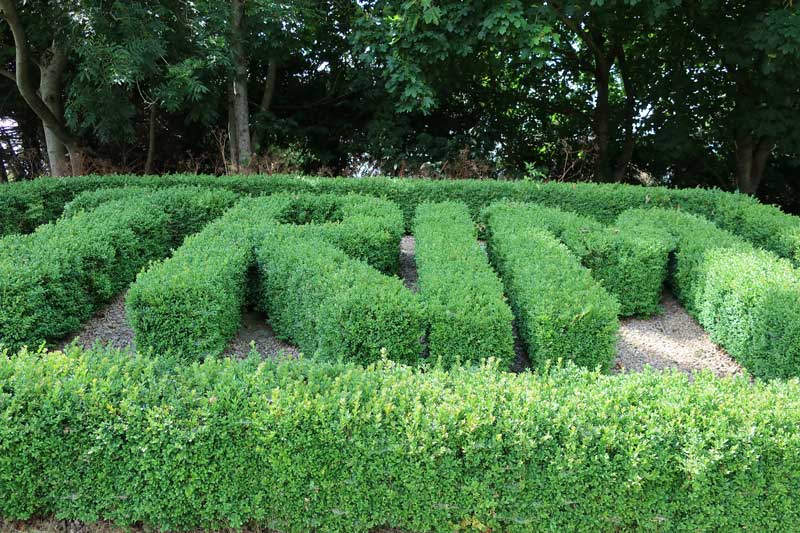
Ask yourself: does this site really need intricate hedging that needs to be constantly maintained? Or could we replace fast-growing hedges with something requiring a lot less maintenance? https://commons.wikimedia.org/wiki/File:Topiary_hedge,_Trim,_Country_Meath,_Ireland.jpg
Why Landscape Designers Should Reduce the Maintenance Requirements
Envisioning maintenance requirements at the design stage and reducing them brings a multitude of benefits, both for the environment and for those tasked with a landscape’s upkeep. By incorporating low-maintenance plants and thoughtful design strategies, landscape designers can initiate spaces that are not only aesthetically pleasing but also sustainable and economical.
Lower maintenance landscapes require less water, fewer chemical treatments, and reduced labour, which contributes to environmental conservation and cost savings.
Factors That Contribute to Landscape Maintenance
Several key factors influence the maintenance demands of a landscape. These include plant selection, soil quality, climate conditions, and design layout.
Choosing hardy, condition-tolerant, and pest-resistant plants can significantly reduce maintenance needs. The quality of the soil impacts how often plants need watering and fertilising. Climate conditions such as rainfall patterns and temperature fluctuations also play a role in maintenance requirements.
You can save money and water on irrigation by selecting plants that can thrive on the seasonally available rainwater. Save money on drainage by selecting buffer plants that can tolerate the periodic drought and flooding that a rain garden experiences in a depressed part of the landscape. Save maintenance with frost-hardy plants that don’t need to be protected.
Fast-growing plants are appealing because they fill a space more quickly, but on the flip side, they need constant pruning. On the other hand, slow-growing plants take longer to mature but they may only need to be pruned once ever year or two.
Fertilising plants generously can cause them to grow more quickly, increasing the cost of both fertiliser usage and pruning. While it’s still a good idea to fertilise plants every year or two in early spring, the garden may not need as much fertiliser as you’d think. Especially if you’re using plants that can tolerate poor soils like westringias, callistemons, lomandras, dianellas, rhagodias, gazanias, etc.
Make sure that plants are accessible for maintenance. Installing a green wall may seem like a great idea until you realise you’ll need a maintenance crew to visit several times a year with an Elevated Work Platform (EWP) and shut part of the site down.
A well-thought-out design that considers pruning, pests and diseases, irrigation systems, and ease of access can either streamline maintenance tasks or complicate them. Understanding these factors enables landscape designers to create efficient and manageable outdoor spaces.
Why Slow-Growing Plants Are Lower Maintenance Than Fast-Growing Plants
Slow-growing plants inherently require less frequent attention compared to their fast-growing counterparts. They need less frequent pruning to maintain shape and size, which reduces the labour involved in keeping the landscape tidy.
Additionally, slow-growing plants often establish themselves more robustly over time, leading to healthier root systems that are better at accessing water and nutrients. This resilience means they demand less frequent fertilisation and watering, contributing to their overall lower maintenance profile.
Why drought-Tolerant Plants Are Lower Maintenance Than Thirsty Plants
Drought-tolerant plants are adapted to survive on minimal water, which is particularly beneficial in gardens without irrigation or for gardeners aiming to conserve water. Unlike thirsty plants that require consistent irrigation, drought-tolerant varieties thrive with infrequent irrigation, reducing not only water usage but also the time and effort spent on watering routines.
It’s still a good idea to give them a good, deep watering in dry periods to keep them looking vibrant and healthy. However, once they’re established, some plants can hold on for several years of drought without any irrigation at all.
Pest-Resistant Plants Are Lower Maintenance Than Pest-Prone Plants
Pest-resistant varieties are less likely to suffer from infestations, thereby reducing the need for chemical treatments and constant monitoring. These plants possess natural defences against common pests, which means they require fewer interventions to stay healthy.
This not only lowers the maintenance burden but also supports a more eco-friendly approach by decreasing reliance on pesticides. Implementing pest-resistant plants in a landscape design ensures that the space remains robust and attractive with minimal effort from the gardener.
Isabella® Liriope muscari ‘LIRF’ PBR
Isabella® Liriope muscari ‘LIRF’ PBR is a fine leaf compact spreading plant that displays beautiful pink flowers. It serves as an excellent lawn alternative and garden border, outperforming Mondo grass particularly in full sun conditions and across various regions in Australia. This resilient plant supports heavy shade, frost, drought, and humidity, making it a versatile choice for many landscapes.
Size:
When fully grown, Isabella® Liriope reaches a height of 40 cm and spreads to a width of 50 cm. When mown once a year, its height is maintained at 15-20 cm and width at 20-30 cm.
Why It’s Low Maintenance:
Isabella® Liriope is considered low maintenance due to its minimal mowing requirement—just once per year. Additionally, it exhibits exceptional recovery from damage and thrives under various environmental stressors such as drought and frost. It can also be used effectively in both sunny and shady areas, reducing the need for ongoing adjustments or special care.
Requirements:
- Soil: Suitable for all soil types.
- Sun: Can be planted in full sun to 90% shade.
- Water: Requires consistent watering for the first 8-13 weeks post-planting until established. Thereafter, it is drought-tolerant.
- Planting: For full coverage as a lawn alternative, plant 6 per square metre (for coverage in 18-24 months) or 12 per square metre (for quicker coverage in 9-12 months). Use chunky mulch if not used as a lawn alternative. Optionally, apply slow-release fertiliser in spring.
Where It Works:
New South Wales, Australian Capital Territory, Queensland, Victoria, South Australia, Western Australia, Tasmania, Northern Territory.

https://www.ozbreed.com.au/plant-ranges/strappy-leaf-plants/isabella-liriope/
Little Jess™ Dianella caerulea ‘DCMP01’ PBR
Little Jess™ Dianella is a popular dwarf plant with a clumping growth habit and very short, compact canes that do not fall over. It produces an abundance of purple flowers from September to November and is known for its exceptional drought tolerance, even surpassing other Dianella caerulea varieties such as Breeze® Dianella.
Size:
The plant reaches a height of 40 cm and spreads to a width of 40 cm.
Why It’s Low Maintenance:
Little Jess™ Dianella requires trimming approximately every 8 years. For optimal appearance in gardens, pruning every 2-3 years is recommended, and every 4-8 years for roadside plantings. Its sturdy canes do not collapse, instead partially disappearing beneath the foliage once spent. This reduces the need for frequent deadheading.
Requirements:
- Soil: Suitable for a wide variety of soils except very poor soils.
- Sun: Thrives in full sun and moderate to heavy shade.
- Water: Requires consistent watering for the first 8-13 weeks post-planting until established. Thereafter, it’s highly drought-tolerant.
- Planting: Plant at a density of 6-10 plants per square metre or 3-5 plants per linear metre. Use chunky mulch and ensure the crown or base of the plant is not below soil or mulch level. Apply slow-release fertiliser in spring if necessary.
Where It Works:
New South Wales, Australian Capital Territory, Queensland, Victoria, South Australia, Western Australia, Tasmania

https://www.ozbreed.com.au/plant-ranges/strappy-leaf-plants/little-jess-dianella/
Evergreen Baby™ Lomandra labill ‘LM600’ PBR
Evergreen Baby™ Lomandra is a tough compact, fine-leaved, evergreen plant. It handles both drought and flooded conditions as well as a variety of soil conditions, making it an excellent choice for areas requiring a small yet resilient Lomandra. This variety produces golden flowers in the spring and is male sterile.
Size:
The plant reaches a height of 40-45 cm and spreads to a width of 45 cm.
Why It’s Low Maintenance:
Evergreen Baby™ Lomandra requires a hard prune only every 3-5 years to maintain its appearance, though pruning every 3 years is recommended for optimal looks. It is highly tolerant of drought, frost, and periodic wet feet, which reduces the need for frequent intervention.
Requirements:
- Soil: Suitable for sandy loam to heavy clay soil types.
- Sun: Thrives in full sun to part shade.
- Water: Requires consistent watering for the first 8-13 weeks post-planting until established. Occasional watering may be needed during dry periods.
- Planting: Plant at a density of 4-8 plants per square metre or 2-4 plants per linear metre. Use chunky mulch and ensure the crown or base of the plant is not below soil or mulch level. Apply slow-release fertiliser in spring if necessary.
Where It Works:
Queensland (excluding northern QLD), New South Wales, Australian Capital Territory, Victoria, South Australia, Western Australia.

https://www.ozbreed.com.au/plant-ranges/strappy-leaf-plants/evergreen-baby-lomandra/
Double Gold™ Gazania hybrid ‘GT20’ PBR
Double Gold™ Gazania is a fast-establishing, sterile spreading ground cover adorned with masses of yellow flowers that bloom for most of the year. It boasts twice the number of flowers compared to other Gazania varieties and maintains clean foliage. This plant is excellent for soil stabilisation and effectively outcompetes weeds.
Size:
The plant grows to approximately 20 cm in height and spreads to a width of 60 cm.
Why It’s Low Maintenance:
Double Gold™ Gazania requires minimal care once established. Its ability to outcompete weeds and its sterility—which prevents seed production in itself and crossing with other gazanias—means it does not require frequent maintenance. Additionally, it performs well in various environmental conditions, including frost and mild humidity.
Requirements:
- Soil: Suitable for free-draining to heavy clay soils.
- Sun: Thrives in full sun.
- Water: Needs consistent watering for the first 8-13 weeks post-planting until established. Thereafter, it’s drought-tolerant.
- Planting: Plant at a density of 3-5 plants per square metre or 2-4 plants per linear metre. Use chunky mulch in a well-mulched garden. Optionally, apply slow-release fertiliser in spring. Trim after flowering if necessary.
Where It Works:
New South Wales, Victoria, Tasmania, South Australia, Western Australia, Queensland (excluding northern QLD).
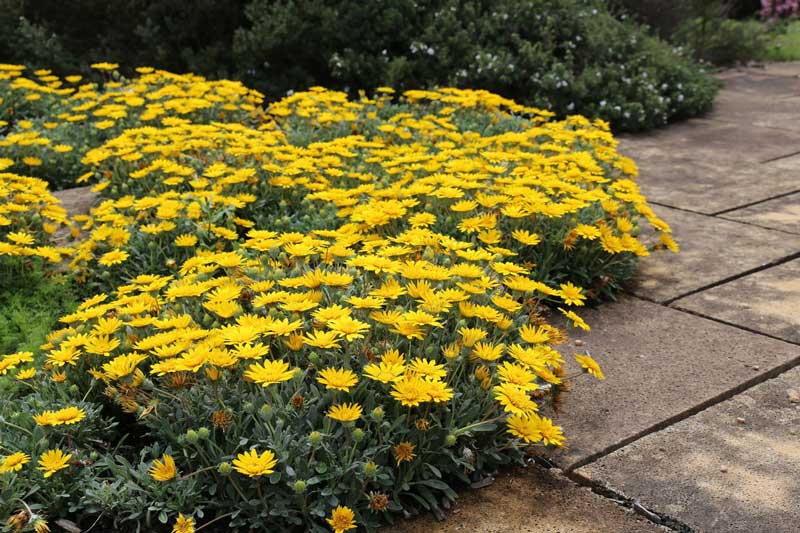
Sweet Privacy™ Murraya paniculata ‘MP01’ PBR
Sweet Privacy™ Murraya is a versatile plant ideal for use as a fence-high or head-high screen. It features beautiful, sweet-smelling white flowers that bloom in spring, late summer, and early autumn.
Size:
The plant grows to a height of 1.8-2.5 metres and spreads to a width of 1.5 metres.
Why It’s Low Maintenance:
Sweet Privacy™ Murraya requires significantly less pruning than the common form—only 2-3 times a year at most. Compare this with other varieties, which may need 8 prunes per year for the same appearance. If you’re after a low-maintenance screening or hedging plant that produces a delightful aroma when in flower, it’s hard to go past this cultivar.
Requirements:
- Soil: Suitable for most soil types.
- Sun: Thrives in full sun to part shade.
- Water: Requires consistent watering for the first 8-13 weeks post-planting until established. Water as needed thereafter, mainly during dry spells when you can water deeply but infrequently.
- Planting: Plant at a density of 1 plant per square metre or 1-2 plants per linear metre. Use chunky mulch in a well-mulched garden and apply slow-release fertiliser yearly. Prune twice a year, or three times a year for very tight hedging.
Where It Works:
Queensland, New South Wales, Northern Territory, Victoria, South Australia, Western Australia.
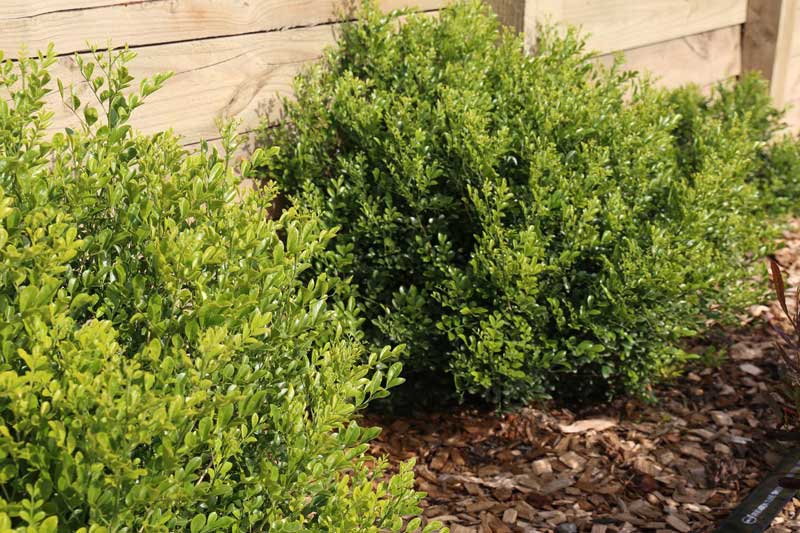
https://www.ozbreed.com.au/plant-ranges/hardy-exotic-range/sweet-privacy/
Thin Red™ Photinia x fraseri ‘NP01’ PBR
Thin Red™ Photinia is a narrow hedging plant with visually striking red new growth foliage. It produces small white flowers in mid to late spring which are both aesthetically pleasing and ecologically beneficial.
Size:
The plant grows to a height of 3-4 metres and has a width of approximately 60 cm.
Why It’s Low Maintenance:
Thin Red™ Photinia has minimal pruning requirements—once a year, or twice per year for a more tidy hedge. Because of its upright growth habit, this plant takes longer to encroach on horizontal space. Its drought tolerance after establishment means that it needs minimal irrigation, if any at all.
Requirements:
- Soil: Works well with most soil types.
- Sun: Thrives in full sun to part shade.
- Water: Requires consistent watering for the first 8-13 weeks post-planting until established. Water as necessary thereafter, with deep watering infrequently being more beneficial than watering little and often.
- Planting: Plant at a density of 1 plant per square metre or 2 plants per linear metre for screening. Use chunky mulch in a well-mulched garden. Apply slow-release fertiliser yearly.
Where It Works:
South Queensland, New South Wales, Victoria, Australian Capital Territory, Tasmania, South Australia, Western Australia.
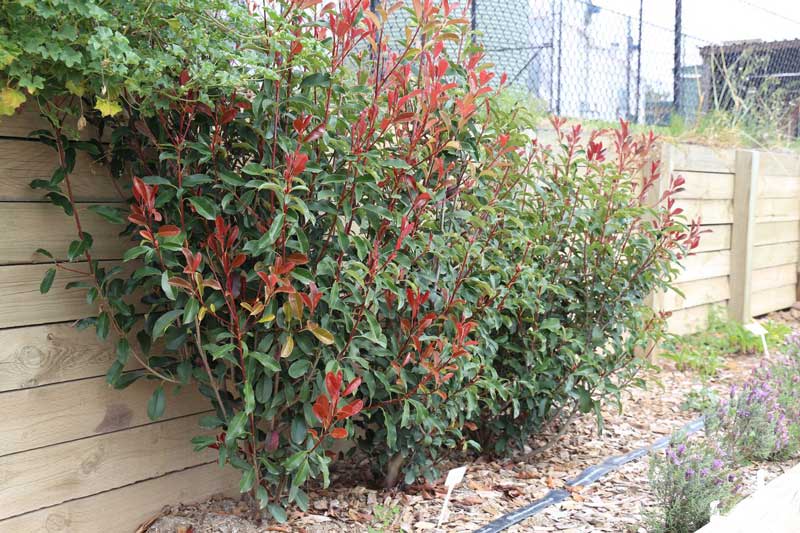
https://www.ozbreed.com.au/plant-ranges/hardy-exotic-range/thin-red/
Ozbreed Zen Grass® Zoysia spp. ‘ZOY01’
Ozbreed Zen Grass® (Zoysia spp. ‘ZOY01’) is a low-maintenance, fast-spreading lawn alternative that features a rippling, undulating surface. It offers a beautiful, dense green appearance throughout summer and winter, making it an excellent choice for aesthetic lawns.
Size:
The plant reaches a height of 10-20 cm and spreads to a width of 1 metre.
Why It’s Low Maintenance:
Ozbreed Zen Grass® requires mowing only once every 1-2 years, significantly reducing upkeep. Its dense growth minimises weed invasion, and it establishes quickly, covering the ground within a single growing season from spring to autumn. It is also resistant to disease and insect damage, as well as short-term flooding, drought, frost and humidity.
Requirements:
- Soil: Suitable for most soil types.
- Sun: Thrives in full sun to heavy shade.
- Water: Requires consistent watering for the first 4-8 weeks post-planting until established. Thereafter, it is highly drought-tolerant.
- Planting: Plant at a density of 4-6 plants per square metre. Using chunky mulch can enhance its undulating appearance and reduce the need for mowing.
Where It Works:
This grass is likely suitable for use Australia-wide, with successful trials in Queensland and the Australian Capital Territory.
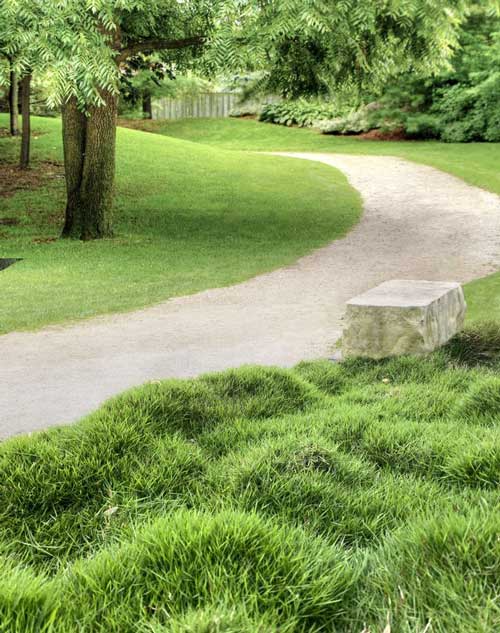
https://www.ozbreed.com.au/plant-ranges/hardy-exotic-range/zen-grass-zoysia/
Aussie Flat Bush™ Rhagodia spinescens ‘SAB01’ PBR
Aussie Flat Bush™ Rhagodia is a low-growing, compact form of saltbush with attractive blue foliage. It’s an excellent ground cover for both inland and coastal landscapes with a high tolerance to salt. It thrives in rockeries, mass plantings and as a low-growing hedge.
Size:
The plant grows to a height of 30-50 cm and spreads to a width of 1 metre.
Why It’s Low Maintenance:
Itbenefits from pruning twice a year to maintain a neat appearance, but it can also be left with infrequent or no pruning when used on roadsides. Its drought tolerance and adaptability to a variety of environmental stresses further reduce the need for frequent care.
Requirements:
- Soil: Suitable for most soil types, including heavy soils.
- Sun: Thrives in full sun to light shade.
- Water: Needs consistent watering for the first 8-13 weeks post-planting until established. After establishment, it is highly drought-tolerant.
- Planting: Plant at a density of 1-2 plants per square metre or 1-2 plants per linear metre. Use chunky mulch in a well-mulched garden. Apply slow-release fertiliser in spring if necessary.
Where It Works:
New South Wales, Australian Capital Territory, Victoria, Queensland (non-humid inland areas), South Australia, Western Australia.

Aussie Rambler™ Carpobrotus glaucescens ‘CAR10’ PBR
Aussie Rambler™ Carpobrotus is a prostrate native Pigface, a type of creeping succulent with long trailing stems that can extend up to 2 metres. It produces large, showy deep pink flowers in spring and autumn, complemented by purple stems. It is ideal for rockeries, mass plantings, and sand dune stabilisation, making it a versatile choice for both inland and coastal gardens.
Size:
The plant grows to a height of 20 cm and spreads to a width of 2 metres.
Why It’s Low Maintenance:
Aussie Rambler™ Carpobrotus tolerates frost, drought, humidity, and salt. Once established, it requires minimal watering and pruning only when it outgrows its allotted space. You can hedge-prune the stems behind the garden border. Selectively remove some of the larger stems to slow growth down as the plant matures.
Requirements:
- Soil: Suitable for most soil types but avoid prolonged wet feet.
- Sun: Thrives in full sun to light shade.
- Water: Needs consistent watering for the first 8-13 weeks post-planting until established. Thereafter, it’s drought tolerant.
- Planting: Plant at a density of 1-2 plants per square metre. Use chunky mulch in a well-mulched garden. Apply slow-release fertiliser in spring if needed. Prune only if required.
Where It Works:
Queensland (excluding northern QLD), New South Wales, Australian Capital Territory, Victoria, Tasmania, South Australia, Western Australia.
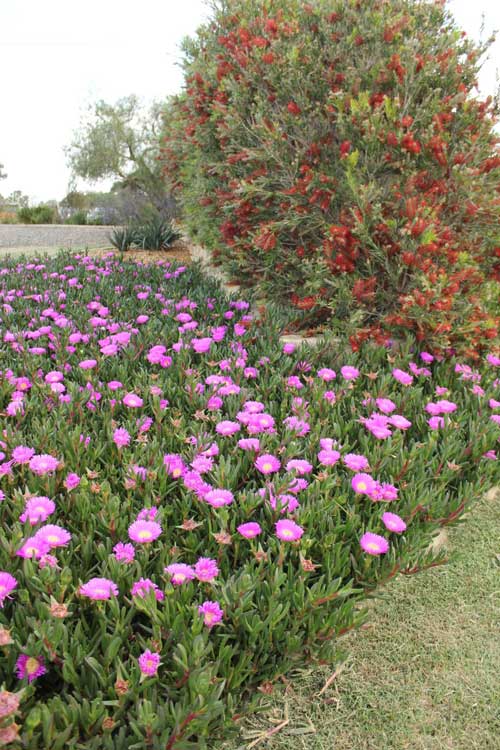
Better John™ Callistemon viminalis ‘LJ1’ PBR
Better John™ Callistemon is an improved cultivar bred from Little John that’s quicker to established, tolerant of drought and flooding, and disease-resistant. It features blue-green toned mature foliage with new growth exhibiting silver hues due to its soft, hairy texture. This plant produces small red flowers that bloom from mid to late spring.
Size:
The plant reaches a height of 60 cm to 1.2 metres and spreads to a width of 60-90 cm.
Why It’s Low Maintenance:
Better John™ Callistemon is easier to grow and quicker to establish compared to its predecessor, Little John. Its compact size and minimal pruning—every 3-4 years for a natural shape or every 2 years for a tidy hedge—make it an excellent low-maintenance option. It’s resistant against myrtle rust and phytophthora, while also being tolerant of drought, flooding and cold conditions.
Requirements:
- Soil: Suitable for heavy to well-drained soils.
- Sun: Thrives in full sun to part shade.
- Water: Requires consistent watering for the first 8-13 weeks post-planting until established. Thereafter, it’s drought tolerant.
- Planting: Plant at a density of 3-5 plants per square metre or 1.5-2 plants per linear metre. Use chunky mulch in a well-mulched garden. Apply slow-release fertiliser in spring if necessary.
Where It Works:
Queensland, New South Wales, Australian Capital Territory, Victoria, Tasmania, South Australia, Western Australia.
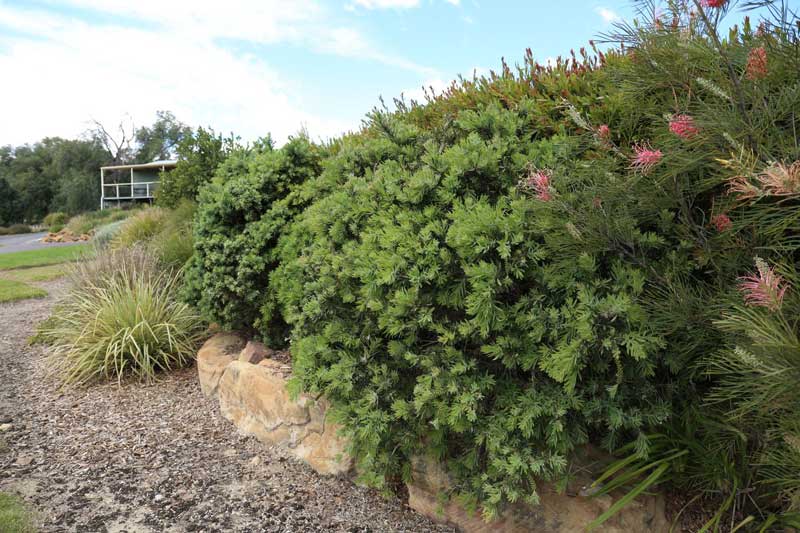
Ozbreed Flat White™ Pandorea jasminoides ‘PJ01’ PBR
Ozbreed Flat White™ Pandorea is a dense and compact climber that showcases masses of pure white flowers in late spring and summer. It’s perfect for narrow spaces and covering fences and trellises, as long as it gets at least 4 hours of sunlight each day.
Size:
The plant grows to a height of 2-3 metres and a width of 40-60 cm when pruned, or 80 cm-2 metres when unpruned.
Why It’s Low Maintenance:
Ozbreed Flat White™ Pandorea requires pruning only twice a year to maintain its shape as a narrow, tight climber. It’s slower-growing and longer-lived than other climbers.
Requirements:
- Soil: Suitable for most soil types.
- Sun: Thrives in full sun to part shade.
- Water: Needs consistent watering for the first 8-13 weeks post-planting until established. Water as required thereafter.
- Planting: Plant at a density of 1-3 plants per linear metre. Use chunky mulch in a well-mulched garden. Apply slow-release fertiliser in spring if necessary. Prune a few months after planting and then twice a year.
Where It Works:
South Queensland, New South Wales, Victoria, Tasmania, South Australia, Western Australia.

https://www.ozbreed.com.au/plant-ranges/native-shrubs-groundcovers/ozbreed-flat-white/
Grey Box™ Westringia fruticosa ‘WES04’ PBR
Grey Box™ Westringia is a compact native shrub that provides calming colour with its grey foliage and white flowers that bloom from September to May. It’s a great alternative to the English Box, perfect as a hedge or left unpruned in its natural ball shape.
Size:
The plant reaches a height of 30-45 cm and a width of 30-45 cm when unpruned. When pruned, it maintains a compact size of 30 cm by 30 cm.
Why It’s Low Maintenance:
Grey Box™ Westringia is low maintenance due to its frost, drought and flood tolerance as well as minimal pruning requirements. It can be left in its natural tidy shape or pruned 1-3 times a year after flowering for a more structured look.
Requirements:
- Soil: Suits most soil types.
- Sun: Thrives in full sun to light shade.
- Water: Needs consistent watering for the first 8-13 weeks post-planting until established. Thereafter, it’s drought tolerant.
- Planting: Plant at a density of 3-6 plants per square metre or 2-3 plants per linear metre. Use chunky mulch in a well-mulched garden. Apply slow-release fertiliser in spring if necessary.
Where It Works:
Queensland, New South Wales, Australian Capital Territory, Victoria, Tasmania, South Australia, Western Australia.

Pink Fusion™ Scaevola spp. ‘PFS200’ PBR Intended
Pink Fusion™ Scaevola is a remarkably tough and elegant flowering ground cover. This native Australian plant boasts compact green foliage adorned with stunning pink fan flowers almost all year round. It’s a practical and decorative choice for public landscapes, cottage gardens and harsh roadside conditions.
Size:
The plant reaches a height of up to 30 cm and a width of up to 1.2 metres in good soils, or 80 cm in poorer soils.
Why It’s Low Maintenance:
Pink Fusion™ Scaevola is incredibly low maintenance due to its exceptional drought tolerance and ability to thrive in extreme wet conditions. It will continue to spread in a garden bed, so you can choose whether you want to prune it once per year to maintain its shape, or allow it to cover the entire bed and then shear it back to the garden edge. Alternatively, selectively prune large stems back to reduce the bulk of the plant, especially when natural shape is preferred such as when it cascades down rockeries. Its dense foliage reduces weed infiltration, and its longevity is proven, as initial plantings have thrived for over a decade with practically no maintenance.
Requirements:
- Soil: Suitable for most soil types, including poor soils.
- Sun: Thrives in full sun to light shade.
- Water: Needs consistent watering for the first 8-13 weeks post-planting until established. Thereafter, it’s extremely drought-tolerant.
- Planting: Plant at a density of 1-2 plants per square metre. Use chunky mulch in a well-mulched garden. Trim once a year to keep tidy.
Where It Works:
Likely suitable for use Australia-wide.
https://www.ozbreed.com.au/plant-ranges/native-shrubs-groundcovers/pink-fusion/
Yareena™ Myoporum parvifolium ‘PARV01’ PBR
Yareena™ Myoporum is a hardy ground cover featuring crisp, clean foliage and masses of white flowers. Its thick and woody stems contribute to its longevity, making it a durable option for various landscapes.
Size:
The plant grows to a height of 10 cm and spreads to a width of 1 metre.
Why It’s Low Maintenance:
Yareena™ Myoporum is low maintenance due to its exceptional drought and frost tolerance. It requires minimal pruning—once every two years to keep tidy—and it also suppresses weeds.
Requirements:
- Soil: Suitable for sandy to heavy clay soils.
- Sun: Thrives in full sun to part shade.
- Water: Needs consistent watering for the first 8-13 weeks post-planting until established. Thereafter, it’s drought tolerant.
- Planting: Plant at a density of 1-2 plants per square metre. Use chunky mulch in a well-mulched garden. Apply slow-release fertiliser in spring if necessary. Prune once every two years to maintain a tidy appearance.
Where It Works:
Queensland, New South Wales, Australian Capital Territory, Victoria, Tasmania, South Australia, Western Australia.

Straight and Narrow™ Syzygium australe ‘SAN01’ PBR Intended
Straight and Narrow™ Syzygium is a very slender, columnar shrub or tree. It features tight, attractive leaves and produces white flowers that mature into beautiful pink/red fruit. This plant is ideal for creating screens or hedges in narrow planting areas.
Size:
The plant reaches a height of 5-8 metres and a width of 1-1.5 metres. It can be pruned down to a height of 2 metres.
Why It’s Low Maintenance:
Straight and Narrow™ Syzygium is low maintenance due to its natural Psyllid resistance, reducing the likelihood of pest problems. On top of this, it tolerates cold and dry conditions well. Pruning is only required twice yearly for a tidy hedge or every 2-3 years (or not at all) if used as a wider screen plant.
Requirements:
- Soil: Suits moist, well-drained soil types.
- Sun: Thrives in full sun to shade.
- Water: Requires consistent watering for the first 8-13 weeks post-planting until established. Thereafter, water as needed.
- Planting: Plant at a density of 1 plant per square metre or 1-1.5 plants per linear metre. Ensure the garden is well-mulched with chunky mulch. Apply slow-release fertiliser in spring if necessary.
Where It Works:
Queensland, New South Wales, Victoria, South Australia, Western Australia, and Australian Capital Territory (if protected from frosts)
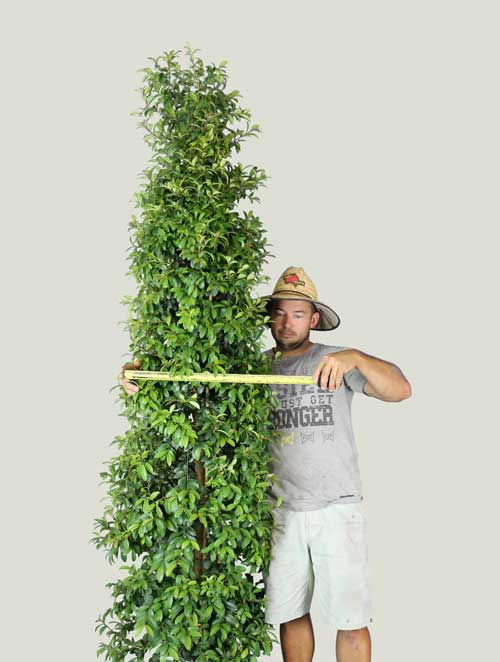
https://www.ozbreed.com.au/plant-ranges/native-shrubs-groundcovers/straight-and-narrow/
Conclusion
Embracing low-maintenance landscape design is a win-win for the environment, and the person responsible for the maintenance budget. By prioritising slow-growing, drought-tolerant, pest-resistant, and neglect-tolerant plants, designers can initiate beautiful, sustainable, and easy-to-manage outdoor spaces. These landscapes save time and money, reduce water and chemical use, and promote ecological health.
As we move towards more sustainable living, adopting these principles in landscape design not only makes practical sense but also aligns with broader environmental goals. Whether you’re a professional landscape designer or a gardening enthusiast looking to simplify your garden, these strategies offer a path to creating stunning, low-maintenance green spaces.
